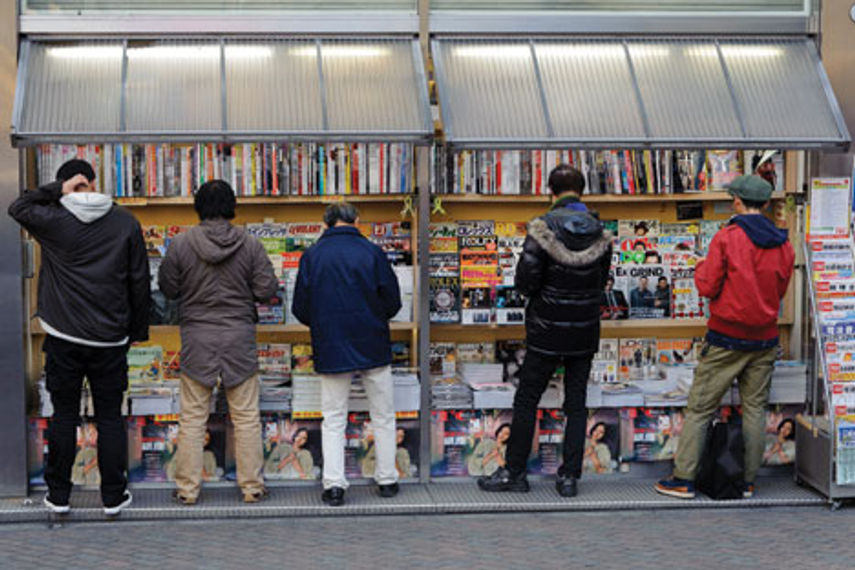
Twenty years after the demolition of the densely populated Kowloon Walled City, a 17-minute documentary has drawn 1.3 million views online since its premier last month. For the Asia bureau of The Wall Street Journal (WSJ), the title behind the film and its ensuing multimedia package, it presents a new editorial experiment.
Today’s digital sphere is opening up exciting opportunities for publications that made their name in print. But as readers migrate online, the decline of print advertising has created gaps. Financing journalism has never been more complicated and varied. Major news groups are reconsidering distribution models: should print editions be limited to major cities? Should home delivery be discontinued? In this fragile environment, the relevance of print comes into question.
“The physical print title is constrained by space,” says Adam Najberg, the WSJ’s digital editor for Asia. “There’s less of a formula with digital.”
With City of Imagination the WSJ wanted to do something “transformative”, says Najberg. “We don’t want to gratuitously do everything at 3,000 words, or every video at 25 minutes, but when you’ve got the opportunity [with digital] it’s easy. We’d like to go in that direction.”
Digital advertising has not compensated for the loss of print spend. But the internet presents publishers with new ways to make money.
“E-commerce seems to be the magazine industry’s golden opportunity to ‘move up the value chain’ and deliver real sales for their advertisers,” writes media consultant Colin Morrison on his blog, Flashes & Flames.
Condé Nast, the publisher of Vogue, has established an e-commerce division in London. Meanwhile the US iPad edition of Cosmopolitan features content purchasable through Shop Advisor technology.
The magazine can earn commission on products it helps sell, as well as revenue from advertising.
Newspapers or news magazines such as the Financial Times (FT), The Economist and WSJ have diversified their products, branching into events, intelligence services and education. “Our business model has changed steadily for the past eight years,” says Angela Mackay, managing director, Asia-Pacific at the FT.
These changes include driving online traffic and the introduction of a corporate subscription service. The FT also offers learning products. One, FT Newslines, allows students and teachers to create and share annotations on FT.com articles. The publication, in turn, becomes embedded in the classroom.
Despite the FT’s online readership now outnumbering that of print, Mackay says the physical paper remains vital. “In some markets, it’s a status symbol to be seen wondering around with a pink paper under your arm,” she says. “We’re still investing in the print model… We’ve got a big advertising campaign around the FT Weekend, because we believe those people who like to digest their news online Monday to Friday still prefer a print product at the weekend, when they can lie back and enjoy themselves.”
Print may be costly for publishers, but it can add an aura of legitimacy. Billionaire.com, a digital magazine aimed at ultra high-net-worth individuals, recently introduced The Billionaire Bulletin. The 32-page print product features content about fashion, watches and yachts. In 2005, Hypebeast was a footwear-orientated blog. Today it’s a publishing empire. Fifty staff members work on a blog and online store that attracts 2.45 million unique users a month, as well as a recently launched quarterly print magazine.
Rather than being dead, print is being redefined.
The Economist, a weekly founded in 1843, is one among several platforms owned by The Economist Group. The parent company oversees research firm The Economist Intelligence Unit, Intelligent Life (a bi-monthly culture magazine), The Economist online, and side businesses including a conference organising unit, Thought Leadership & Events.
This multiplatform format is attractive to advertisers. “The way our clients are coming to us today is not to say, ‘give me a quote for a one page advertisement’,” says David E. Smith, regional director of advertising and sponsorship at The Economist. “They say, ‘can you create a programme for us to reach our target audience?’”
One such programme was launched in 2013. The Economist Group’s Look Ahead campaign for General Electric sought to “cut through the information clutter to connect with business decision-makers”. An editorial team based around the world creates multimedia, articles, slide shows, infographics, videos and interactive polls for a microsite.
The Economist Group was one of the first media stalwarts to delve into native advertising, or brand-generated content in the style of, but distinct from, editorial. WSJ, Forbes, The Atlantic, The Washington Post and The New Yorker have followed suit. The New York Times (NYT) recently rolled out its first native ads for Dell, a three-month campaign reportedly costing a six-figure sum. Like its counterparts, the NYT goes to lengths to distinguish between ‘paid posts’ and editorial. A click on an online ad opens a new browser window with the URL paidpost.nytimes.com.
Such devices are vital for top-tier publications with reputations built on integrity. Native is not without detractors. WSJ managing editor Gerard Baker described such deals between publishers and advertisers a “Faustian pact”.
America’s National Advertising Division recently lambasted Shape magazine, which has a circulation of 1.6 million in the US, for blurring the line between ads and editorial in a way that “could confuse consumers”.
BuzzFeed has made its name with the ‘listicle’, or amalgamations of entertaining memes that often go viral. Its business is built on sharing, which is advertising gold.
Toyota and Emirates have run native ads on BuzzFeed; some have far-reaching success. With the capital generated from native, among other initiatives, BuzzFeed has invested in experienced journalists. Mark Shoofs, the Pulitzer Prize-winner formerly at ProPublica and WSJ, is to head the company’s new investigative unit.
“We plan to mix BuzzFeed’s energy, ambition and grasp of the social web with the best traditions of American investigative reporting,” says Shoofs.


.jpg&h=334&w=500&q=100&v=20170226&c=1)
.jpg&h=334&w=500&q=100&v=20170226&c=1)

.png&h=334&w=500&q=100&v=20170226&c=1)












